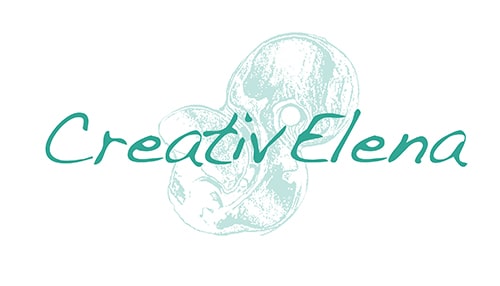“When was the last time you did something for the first time? And: How did it make you feel? I am interested in your very own, individual experiences …”, I encourage my participants in our two-day weekend seminar in Waidhofen an der Ybbs to share from their rich fundus of memories. More than once, I am thinking: I have to particularly motivate them, after long days of our prior EU “EuropeTour” project convention, to continue their attention span all weekend. More than once, they have collectively proven me wrong: Ruth Jung of the German city Bad Wimpfen, Jens Schmuckal from nearby Jagsthausen, Sandra Holte & Tanja Seegelke of the tourism destination management company HeilbronnerLand as well as Karin Drda-Kühn representing the local Kiratour network for cultural tourism. “We are all here to learn from you”, Karin continues to emphasise. And yet: To receive so much energy, interest and dedication from participants to your seminar cannot always be taken for granted – and really helped us to build something interesting here.
Two days on end, we talked about effective elements to improve digital marketing opportunities in cultural tourism in rural areas.
But let us first go back to those “first times”. How did our participants feel during these special types of experiences, when did they last experience it, and what were they like?
“Exciting … Intense … An adventure … Pleasure … Discovery … Opening up.” Words from our quick brainstorming during the seminar. Which leads us to where I wanted us to go: Experiences are inherently tied to emotions. And to be able to feel them, to experience a level of personal involvement and trust in the experience, you may need time, courage, but most certainly, a story, one or more heroes, good storytelling techniques and the ability of the reader or the participant to open up, and allow themselves to be engaged, at the other end. To engage with a situation, another human being, or sometimes an entire region or business who “runs” and lives a story like no one else. Such are the stories are told by the Lower Austrian Mostviertel district, and it is here where we start our discussion from, talking about cultural tourism networks, their emotions and stories that link all people and business providers in the area.
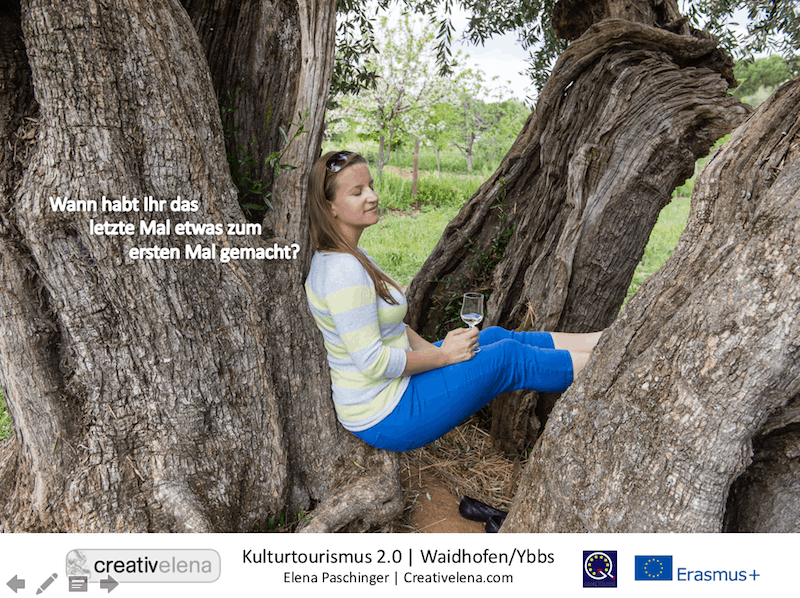
Off we go on our seminar “Kulturtourismus 2.0” in Waidhofen an der Ybbs: Storytelling in cultural tourism often starts with a simple question like this one: “When was the last time you did something for the first time?”

The Lower Austrian Mostviertel destination is marked by many small, successful producers tied up in local agricultural and tourism networks, showing strength on a supra-regional level. During the seminar, we discuss their potential 2.0 and check out some of their websites for tourism.

Another example for interesting digital storytelling is provided by the local art museum “Kunstmuseum Waldviertel”, whose website I encourage you to check out here.
The creative destination Altenmarkt-Zauchensee also looks at creative cultural tourism for honing its particular skills and developing networks so as to achieve a USP that distinguishes them from all other areas in the Salzburger Land district, offering all too similar alpine summer experiences. It does so quite successfully, as discussing recent experiences of mine have shown discussing with my participants during our workshop.
So what exactly is Social Media Marketing, how do we achieve a strategy & networking, how to continue doing evaluation when parameters change and shift constantly? Burning topics that my participants and I discuss in our two-day weekend workshop.
Many are the answers we come up with, and great are the benefits shared among our team of less and more experienced Social media partners (Tanja Seegelke, for instance, has already hosted several Social Media workshops herself for business partners in the Heilbronner Land).

Summing up, what I’m saying here is that Social Media should be used regularly, posting videos, photos and/or stories to specific target groups, using it as a tool to maintain dialogue and exchange, rather than always blasting out your own opinion to others.
In the digital (Social Media) age, the four P’s of classic marketing (“Product, Price, Place, Promotion”) continue to shift in favour of the four C’s: “Creating, Curating, Connecting, Culture.” This is reflected in the paradigm change that continues to affect not only Social Media marketing, or cultural tourism in rural areas, but also society as a whole. The basic notion is that we create something, then share it, link it, network it, moderate discussions about it instead of trying to convince people of its benefits with traditional advertising. Rather, it is all about allowing your customers to experience your product, become ambassadors for it, and moderate their own discussion / feedback about it.
Social Media, and that remains to be said, is not a direct sales channel. Or do you think, Sweden wants to sell itself using its recent “Call Sweden” campaign? Go on, then: Have you already called Sweden? 🙂
Besides discussing Do’s & Don’ts in Social Media Marketing, the second day of our seminar saw us talking about successful online storytelling & influencer relationship management tools.
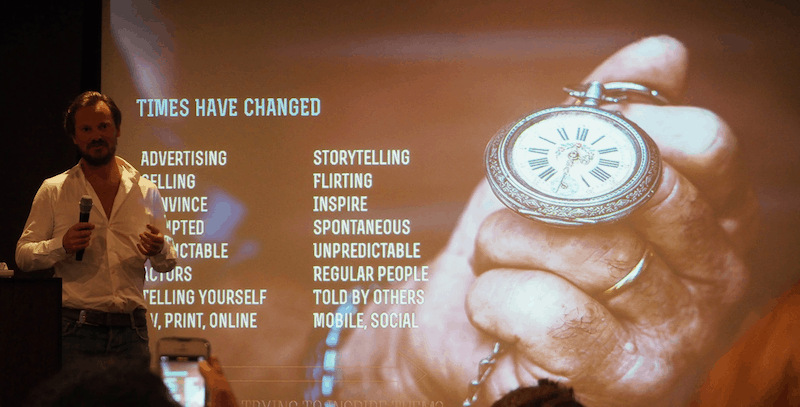
Starting with an example slide provided by Caspar Diderik aka StoryTravelers, who during The Social Travel Summit in Hamburg last year hit the nail with his above comparison.
The above conclusions on changing times go in line with his video #OutThere, following a cooperation with the sportswear company Carrera. Why, according to your opinion, can this be a good example for content marketing in tourism?
Admittedly, the video is visually impressive, releasing emotions and connecting viewers to the Carrera sportswear brand as well as the countryside around Evora, southwest of the Portuguese capital city Lisbon – even when this connection would at first seem quite unlikely. The message is being placed in a very subtle way. Thank you, Caspar & StoryTravelers, for a great visual reminder of successful storytelling!
The Austrian National Tourist board, too, has given a lot of thought on the successful management of influencer relations, recently hosting two travel campaigns #inAustria (summer & winter editions):
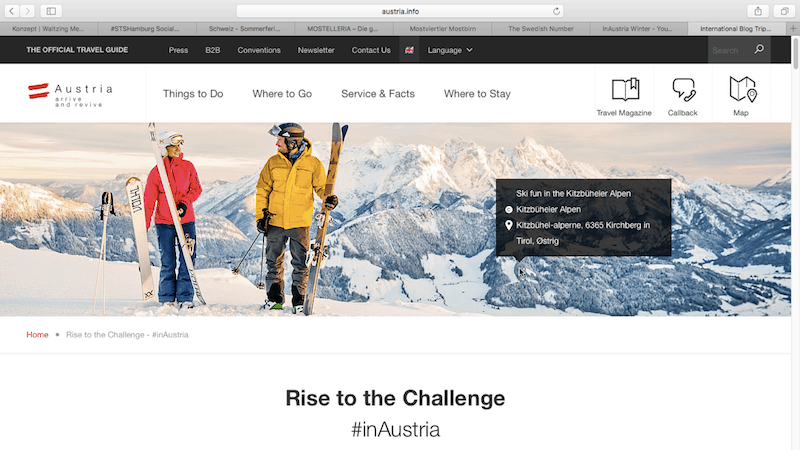
It goes in line with its international media campaign, curating blogger’s content through a social wall.
Interesting also what the “Meurer’s” are doing, especially here in the German speaking markets: Check out their Social Media concept for social influencers and tourism destinations here. Kristine Honig recently developed an all-time first, creating the “blogger data base” Find-A-Blogger.com. In the discussion that follows, our seminar participants conclude that storytelling should hold some of the following key elements and be:
- Lively & attractive
- From a personal point of view
- Relevant to target audiences
- Full of emotions
- Using blogs as a medium for dialogue.
I like to quote another master of his genre here, Don George of Lonely Planet Travel Writing, who I first heard give a speech at TBEX Dublin all those years ago:
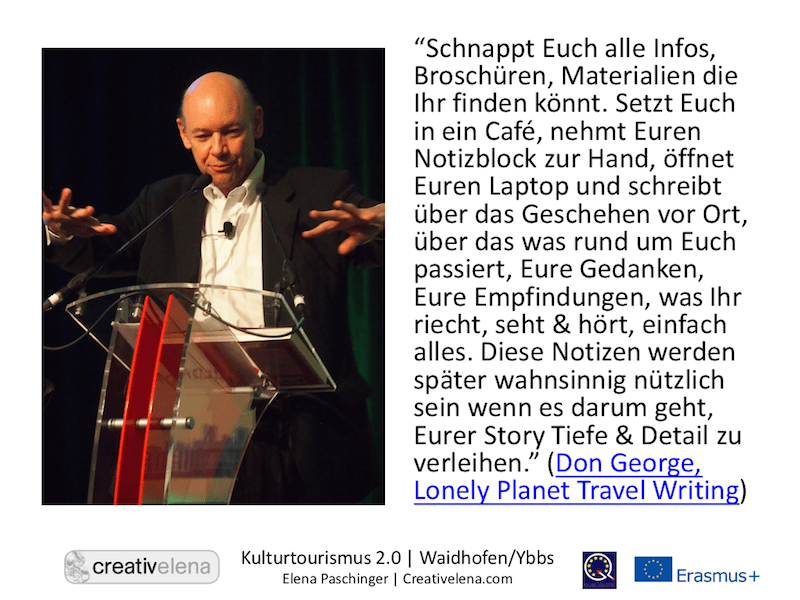
In my slide, I basically sum up what he says on the key elements of storytelling: “Gather details, add depth to your stories, note down anything & everything. It will truly allow you to develop great stories from wherever you go.”
So what remains? What is it, we ask at the end of our seminar, going back to cultural tourism and its particular elements and requirements vis-a-vis storytelling?
A good name, for instance. One that already is storytelling per se.
One example for this is the “1st Austrian Scything School” here in the Lower Austrian culture park of the Iron Trail. Or let me ask you this: Have you ever tried to mow a mountain lawn?!
Perhaps we all need something like the “1st Austrian Scything School”. Something that inherently carries the promise of a story, something that easily distinguishes itself from many other offers around, something invariably tied to a local area, its customs and traditions, expressing depth and meaning for storytelling as merely a vector of its own force?
Then, Social Media can be used for what it does best: Work as a clever tool to display stories, linking observers and content creators, furthering the discussion about extraordinary places and outstanding people. In a community where we are all willing to learn, share and network with each other, constantly improving our own skills and inspiring those of others.
So, my dear readers. I’m tempted to say: See you at our next Social Media / Cultural Tourism seminar! 😀

My dear seminar participants, from left to right: Sandra Holte, Jens Schmuckal, Tanja Seegelke, Karin Drda-Kühn and Ruth Jung.

Such a great feeling knowing my book in the hands of those wonderful people, all of them cultural tourism & Social Media experts from Southern Germany !!
